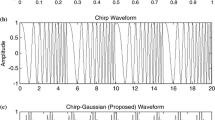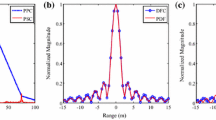Abstract
The radar waveform design evaluates the target detection, range, and velocity. The performance depends on its structure and resolution. In this paper, ultra-wideband waveform (UWB) design techniques are presented in two-dimensional and three-dimensional scenarios. The ambiguity function is a three-dimensional and two-variable mathematical tool, which demonstrates both range and Doppler resolution capabilities of the waveform. The ambiguity function and autocorrelation functions are used to evaluate the target parameters by studying their surfaces. This paper demonstrates the important results of two-dimensional and three-dimensional plots of non-sinusoidal chirp signals and Barker code of length five. The three-dimensional plots are generated for the above UWB coded signals, UWB chirp signal, and Barker code of length five, and the results are presented. In this paper, range resolution plots of the UWB waveforms are presented and discussed their results in the applications of high-resolution radar for testing detection capabilities. The ambiguity surfaces of the above signals are plotted to determine the range–velocity resolution. The ultra-wideband nonlinear frequency modulated waveform can simultaneously achieve high peak energies and shows high a range and Doppler resolution performance. The delay-Doppler ambiguity function of Barker code of length five using UWB pulses is derived, and their surfaces are examined.
Access provided by Autonomous University of Puebla. Download conference paper PDF
Similar content being viewed by others
Keywords
1 Introduction
The radar transmits [1] the waveforms toward the target, and echoes are reflected back. The transmitted waveform may use different types of waveforms which include narrowband and wideband. The radar which uses UWB waveforms is called as UWB radar [2]. The delay happens between two waveforms [3] which derive the important results like a range of target. Similarly, the changes in the frequency show velocity of target by calculating its Doppler shift. And also the UWB signal processing techniques explain the resolution of the target in a more effective way. There are two important types of resolutions: One is range, and the other one is Doppler. Range resolution may give out discrimination between two closely placed targets. And Doppler resolution may result two closely moving targets. These important results may be derived using UWB waveforms. More interestingly, these waveforms show very high resolution [4] at a short range. There are many advantages of using UWB radar instead of radars with continuous waves described. It requires less power, accuracy of resolution, high data speed at short range, etc. Hence, it has wide applications in defense, medical, and advanced communications.
The minimum bandwidth must occupy more than 25% of the center frequency [5]. The minimum bandwidth must exceed 500 MHz. The total bandwidth that could be occupied as defined by the FCC is from 3.1 to 10.6 GHz.
2 Power Spectral Density (PSD) of UWB Pulses
The power spectral density (PSD) of the Gaussian pulse can be calculated as u(t) is a UWB signal. u(f) is Fourier transform of u(t).
u(f)2 power spectral density of u(t)
The below plots show the performance of the derivations of the basic pulse shape can control the PSD of the monocycle, which in this case is modeled as a Gaussian pulse as shown in Fig. 1. These results show how monocycle shifts for higher-order differentiations.
Another issue is the pulse width, as a Gaussian pulse has infinite duration. This is not, of course, practical and limit to the effective pulse width. Pulse width has always the limitation of such type of waveforms. An effective way to define the pulse width is to choose the pulse width is so that a given percentage of the power in the infinite duration pulse is captured.
3 Waveform Design of UWB Ambiguity Diagrams
The matched filter performs as a correlate receiver, which results both compression and noise suppression. Autocorrelation [6] and ambiguity function show a vital role in the design [4] of radar waveforms.
In this paper, ambiguity surfaces [2] of different UWB waveforms are presented and their performance is discussed in the conclusions. Performance criterion of ambiguity diagrams: Ambiguity diagrams are three-dimensional surfaces [7] and are plotted by taking time delays on the x-axis, Doppler shifts on the y-axis, and resultant amplitudes on the z-axis. Time delays measure range, and Doppler shifts measure the velocity of the targets. The surfaces [8] of ambiguity diagrams demonstrate the range and Doppler resolution of the radar for the transmitted waveforms [9]. The diagram should have a large peak main lobe and minimum side lobe values.
These are also called as “thumbtack” diagrams. These plots avoid the ambiguities between the range and velocity of targets. And minimum side lobes [10] are advantageous to avoid the wrong detection of targets and reducing the constant alarm rate (CFAR).
4 Methodology
The following methodologies are implemented in this paper.
-
i.
UWB waveforms are modeled using ambiguity functions in the field of radar.
-
ii.
Different types of waveforms like UWB Chirp, Barker code, and multiple UWB are simulated using ambiguity functions.
-
iii.
UWB 3D ambiguity surfaces are generated and presented.
-
iv.
The important implications are derived and presented.
-
v.
Suitability of these surfaces in radar design is discussed.
4.1 Range–Velocity Resolution of Multiple UWB Signals
This paper presents the power spectral density curves of multiple ultra-wideband pulses. These plots present how the autocorrelation energy increases as a number of pulses are increased, which is the main criterion of the implementation of these plots to improve the detection capabilities of UWB pulses. The range resolution functions are observed analytically and are presented as two-dimensional surfaces as a function of time delay and autocorrelation energy as shown in Figs. 2 and 3. It is evident from the plots that they show high-energy spectral characteristics and sharp main lobe ambiguity surfaces.
4.2 Range Resolution of UWB Chirp Signal
The We refers to st(t) as the UWB chirp signal in similar to the sinusoidal chirp signal c(t) with the pulse duration in the order of nanoseconds.
A chirp signal having a huge train of UWB pulses derives large energy levels needed for good target detection and the large bandwidth required for greater and greater resolution performance (Figs. 4 and 5).
Barker codes are the popular bi-phase codes which are used in radar applications. The following results as shown in Fig. 6 represent the range and velocity plots of Barker code of length five using UWB pulses with varying pulse widths of 2 and 0.02 ns. Figure 6 shows better resolution characteristics. But side lobes show some significant energy levels, which are undesirable.
5 Conclusions
The ambiguity surfaces of UWB waveforms show narrower main lobe width, and lower side lobes are advantageous in high-resolution radar to resolve the closely spaced targets. The linear frequency modulated waveform shows energy loss in its spectrum in the form of ridges. Analogous to the conventional chirp signal, a UWB chirp signal that is composed of a large number of impulses, provide simultaneously the radiation energy needed for improved target detection and the ultra-wide bandwidth required for achieving high resolution. The features of UWB chirp signal depict the characteristics of the “thumbtack” ambiguity function which is the ideal ambiguity function for high-resolution radar. The UWB chirp waveforms avoid the energy losses because the ridges disappear in its spectrum. The range resolution can be improved because of the high peak autocorrelation values. Because of high autocorrelation peak values and power spectral densities, the detection probability increases. The PSD curves are also observed, and more number of pulses results in higher spectral energy, which is useful for high threshold detection of targets in the presence of noise.
References
Win MZ, Scholtz RA (1997) Comparisons of analog and digital impulse radio for multiple-access communications. In: Proceedings of IEEE international conference on communications. Montreal, PQ, Canada, 91–95 June 1997
Srinivasu C, RajaRajeswari K (2011) Ambiguity surfaces of bi-phase codes using ultra wide band pulses (UWB) in high-resolution radar. Int J Digital Signal Process 3(4):159–164. Coimbatore Institute of Information Technology (CIIT)
Hussain MGM (2007) Waveform design and generalized ambiguity function for ultra wideband non-sinusoidal signals. Electromagn Phenom J 7(1):45–75
Hussain MGM (2007) Waveform design and modulation schemes for impulse communications and radar. In: Proceedings of IEEE third international waveform diversity and design (WDD) conference, Pisa, Italy, pp 260–264
Srinivasu C, RajaRajeswari K (2011) Autocorrelation properties using multiple ultra wideband (UWB) pulses. Int J Eng Sci Technol (IJEST) 3(4):2939–2943
Gill GS (1997) Ultra wideband radar using Fourier synthesized waveform. IEEE Trans Electromagnet Compat 39(2):124–131
Woodward PM (2014) Probability and information theory with applications radar. McGraw-Hill, New York
Fontana RJ, Foster LA, Fair B, Wu D (2012) Recent advances in ultra wide band radar and ranging systems. IEEE Trans Veh Technol 61(8):3630–3642
Scientific Reports (2018) Ultra wideband impulse radar through wall detection of vital signals. Open Online 06 Sep 2018
Van Thi Phuoc N, Tang L (2019) Review-microwave radar sensing systems for search and rescue purposes. Sensors 19(13):2879
Author information
Authors and Affiliations
Corresponding author
Editor information
Editors and Affiliations
Rights and permissions
Copyright information
© 2021 Springer Nature Singapore Pte Ltd.
About this paper
Cite this paper
Srinivasu, C., Monica Satyavathi, D., Markandeya Gupta, N. (2021). Performance Evaluation of UWB Waveforms in High-Resolution Radar. In: Chowdary, P., Chakravarthy, V., Anguera, J., Satapathy, S., Bhateja, V. (eds) Microelectronics, Electromagnetics and Telecommunications. Lecture Notes in Electrical Engineering, vol 655. Springer, Singapore. https://doi.org/10.1007/978-981-15-3828-5_58
Download citation
DOI: https://doi.org/10.1007/978-981-15-3828-5_58
Published:
Publisher Name: Springer, Singapore
Print ISBN: 978-981-15-3827-8
Online ISBN: 978-981-15-3828-5
eBook Packages: EngineeringEngineering (R0)










